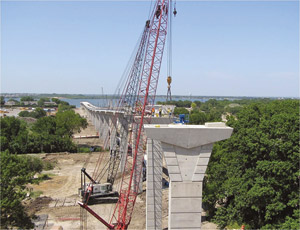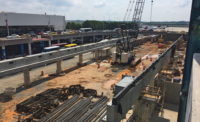With state budgets still hamstrung by the recession and Congress hesitant to hammer out a new federal funding measure, it seems the only thing growing in the U.S. transportation sector these days is the number of firms vying for the few opportunities that do arise.

Infrastructure firms say the moribund commercial construction market has prompted an increasing number of “vertical” contractors to bid on road and bridge projects, creating a buyers’ market for construction services and making it difficult for traditionally infrastructure-focused firms to secure new work.
Jim Andoga, president of Austin Bridge & Road, Irving, Texas, doesn’t fault the agencies for taking advantage of the bargain pricing. “But people are coming into this market that have no business being there,” he says.
However, new projects are out there.The Texas Dept. of Transportation, which has let more than $4 billion in projects over the past year, is benefitting from a $2 billion, two-year transportation bond measure that will support projects such as the $180-million reconstruction of the I-30/President George Bush Turnpike project and the new $154-million interchange between I-30 and state Route 59 in Texarkana.
Three design-build contracts are under way on the 18-mile Inter County Connector in Maryland, with the first seven miles of the $2.6-billion project due to open to traffic later this year. Skanska is working on the $500-million redecking of New York City’s famed Brooklyn Bridge and the $154-million design-build replacement of the Indian River Bridge in Delaware, while the joint venture of Irving, Texas-based Fluor Corp. and American Bridge Co. are building the $1.5-billion, 1,263-ft-long self-anchored suspension span for the San Francisco-Oakland Bay Bridge.
States authorized to use public-private partnerships are relying heavily on these programs to bridge funding gaps. Fluor-Transurban is building the $1.4-billion high-occupancy toll lanes for the western portion of the I-495 Capital Beltway in Virginia. In Florida, Bouygues Civil Works Florida, a subsidiary of Bouygues Publics Travaux of France, broke ground this summer on the $607-million Port of Miami tunnel.
But with the continued slow pace of economic recovery and the impending depletion of American Recovery and Reinvestment Act funding, little of which has gone toward major projects, most firms see only uncertainty ahead.
American Bridge Co. President and CEO Bob Luffy observes that, even if Congress follows the most optimistic predictions and takes up transportation funding after the November elections, “not every state will have money available to fund their share of the projects. In some places, it could be two years before we see any effect from a bill.”
Bill Dorey, president and CEO of Granite Construction Inc., Watsonville, Calif., worries that political reluctance to raise the federal gas tax could stymie the debate, leaving states to muddle through on continued extensions of the SAFETEA-LU formulas.
Further, funding uncertainties have taken some of the luster off high-speed rail, touted as a long-overdue alternative to the nation’s mobility needs. Despite the allocation of $9 billion in federal stimulus grants earlier this year, none of the major projects has broken ground. “Money is crucial to sustaining the momentum of high-speed rail, but nobody knows where it will come from,” Dorey says.
Fortunately, funding uncertainties have yet to dampen any of the major transit and light-rail projects under way around the country. Major projects include Skanska’s $3.8-billion, two-mile-long first phase of the Second Avenue Subway in Manhattan as well as the $3.1-billion, 11.6-mile first phase of Washington, D.C.’s Metrorail system to Dulles International Airport being built by Dulles Transit Partners, the design/build consortium owned by San Francisco-based Bechtel Infrastructure Inc. and URS.
“All the demographic trends point to a greater demand for urban transit,” says Rich Cavallaro, president of Skanska USA Civil, Whitestone, N.Y., which is building a $338-million light-rail line in Norfolk, Va. “It’s one of the first places we should be investing.”




Post a comment to this article
Report Abusive Comment